语言学的名词解释
- 格式:doc
- 大小:46.00 KB
- 文档页数:4
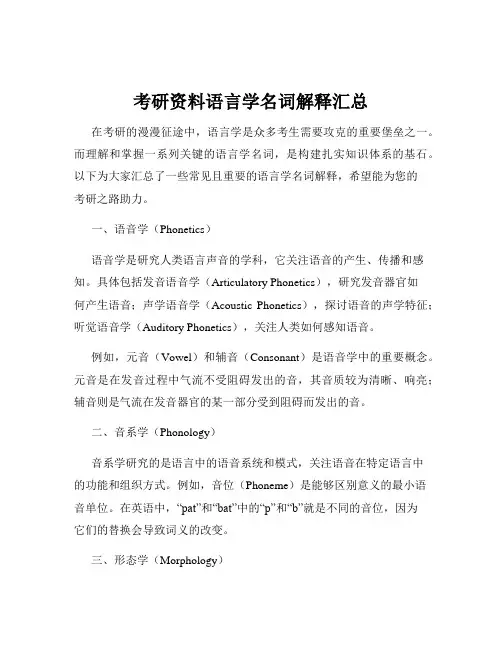
考研资料语言学名词解释汇总在考研的漫漫征途中,语言学是众多考生需要攻克的重要堡垒之一。
而理解和掌握一系列关键的语言学名词,是构建扎实知识体系的基石。
以下为大家汇总了一些常见且重要的语言学名词解释,希望能为您的考研之路助力。
一、语音学(Phonetics)语音学是研究人类语言声音的学科,它关注语音的产生、传播和感知。
具体包括发音语音学(Articulatory Phonetics),研究发音器官如何产生语音;声学语音学(Acoustic Phonetics),探讨语音的声学特征;听觉语音学(Auditory Phonetics),关注人类如何感知语音。
例如,元音(Vowel)和辅音(Consonant)是语音学中的重要概念。
元音是在发音过程中气流不受阻碍发出的音,其音质较为清晰、响亮;辅音则是气流在发音器官的某一部分受到阻碍而发出的音。
二、音系学(Phonology)音系学研究的是语言中的语音系统和模式,关注语音在特定语言中的功能和组织方式。
例如,音位(Phoneme)是能够区别意义的最小语音单位。
在英语中,“pat”和“bat”中的“p”和“b”就是不同的音位,因为它们的替换会导致词义的改变。
三、形态学(Morphology)形态学主要研究词的内部结构和构词规则。
比如,词根(Root)是词的基本部分,承载着主要的词汇意义。
例如,“happy”中的“hap”就是词根。
词缀(Affix)则是加在词根上以改变词义或词性的部分,分为前缀(Prefix)和后缀(Suffix)。
像“unhappy”中的“un”就是前缀。
四、句法学(Syntax)句法学关注句子的结构和组成规则。
比如,句子成分包括主语(Subject)、谓语(Predicate)、宾语(Object)等。
主语通常是句子中表示动作的执行者或主体;谓语则是表达主语的动作或状态;宾语是动作的对象。
五、语义学(Semantics)语义学研究语言符号(词、短语、句子等)与它们所指称的对象之间的关系,即语言的意义。
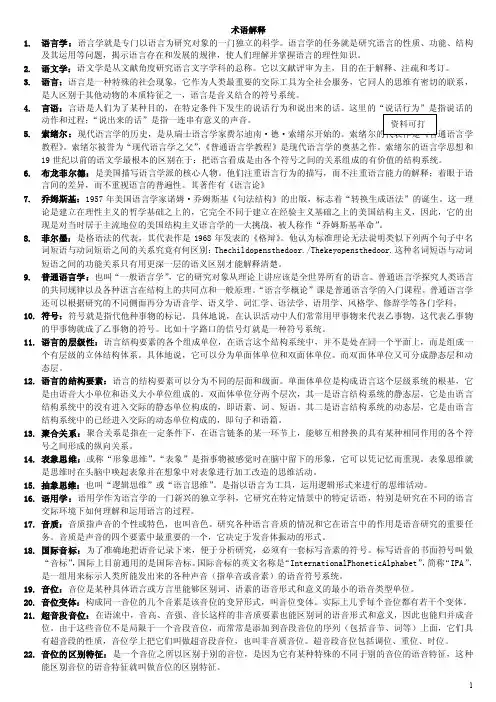
术语解释1.语言学:语言学就是专门以语言为研究对象的一门独立的科学。
语言学的任务就是研究语言的性质、功能、结构及其运用等问题,揭示语言存在和发展的规律,使人们理解并掌握语言的理性知识。
2.语文学:语文学是从文献角度研究语言文字学科的总称。
它以文献评审为主,目的在于解释、注疏和考订。
3.语言:语言是一种特殊的社会现象,它作为人类最重要的交际工具为全社会服务,它同人的思维有密切的联系,是人区别于其他动物的本质特征之一,语言是音义结合的符号系统。
4.言语:言语是人们为了某种目的,在特定条件下发生的说话行为和说出来的话。
这里的“说话行为”是指说话的5.索绪尔:教程》。
索绪尔被誉为“现代语言学之父”,《普通语言学教程》是现代语言学的奠基之作。
索绪尔的语言学思想和19世纪以前的语文学最根本的区别在于:把语言看成是由各个符号之间的关系组成的有价值的结构系统。
6.布龙菲尔德:是美国描写语言学派的核心人物。
他们注重语言行为的描写,而不注重语言能力的解释;着眼于语言间的差异,而不重视语言的普遍性。
其著作有《语言论》7.乔姆斯基:1957年美国语言学家诺姆·乔姆斯基《句法结构》的出版,标志着“转换生成语法”的诞生。
这一理论是建立在理性主义的哲学基础之上的,它完全不同于建立在经验主义基础之上的美国结构主义,因此,它的出现是对当时居于主流地位的美国结构主义语言学的一大挑战,被人称作“乔姆斯基革命”。
8.菲尔墨:是格语法的代表,其代表作是1968年发表的《格辩》。
他认为标准理论无法说明类似下列两个句子中名词短语与动词短语之间的关系究竟有何区别:Thechildopensthedoor./Thekeyopensthedoor.这种名词短语与动词短语之间的功能关系只有用更深一层的语义区别才能解释清楚。
9.普通语言学:也叫“一般语言学”,它的研究对象从理论上讲应该是全世界所有的语言。
普通语言学探究人类语言的共同规律以及各种语言在结构上的共同点和一般原理。
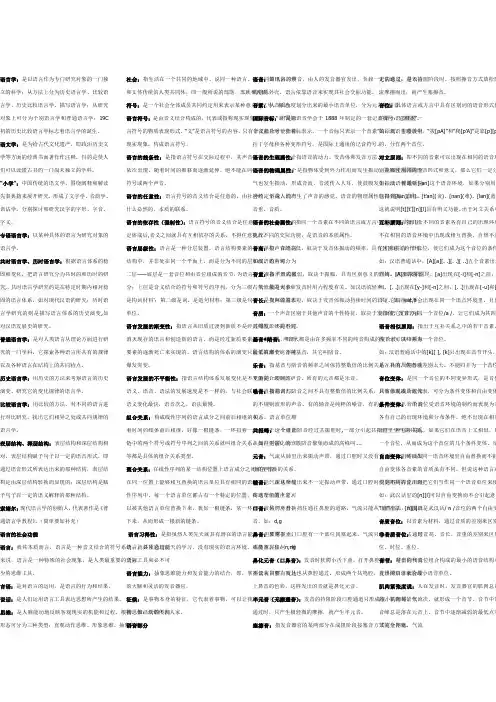
语言学:是以语言作为专门研究对象的一门独立的科学;从方法上分为历史语言学、比较语言学、历史比较语言学、描写语言学;从研究对象上可分为个别语言学和普通语言学;19C 初的历史比较语言学标志着语言学的诞生。
语文学:是为给古代文化遗产,即政治历史文学等方面的经典书面著作作注释,目的是使人们可以读懂古书的一门尚未独立的学科。
“小学”:中国传统的语文学,围绕阐释和解读先秦典籍来展开研究,形成了文字学、音韵学、训诂学,分别探讨和研究汉字的字形、字音、字义。
专语语言学:以某种具体的语言为研究对象的语言学。
共时语言学、历时语言学:根据语言体系的稳固和变化,把语言研究分为共时的和历时的研究,。
共时语言学研究的是在特定时期内相对稳固的语言体系,如对现代汉语的研究;历时语言学研究的则是描写语言体系的历史演变,如对汉语发展史的研究。
普通语言学:是对人类语言从理论方面进行研究的一门学科,它探索各种语言所共有的规律以及各种语言在结构上的共同特点。
历史语言学:用历史的方法来考察语言的历史演变、研究它的变化规律的语言学。
比较语言学:用比较的方法,对不同的语言进行对比研究,找出它们相异之处或共同规律的语言学。
表层结构、深层结构:表层结构和深层结构相对,表层结构赋予句子以一定的语音形式,即通过语音形式所表达出来的那种结构,表层结构是由深层结构转换而显现的;深层结构是赋予句子以一定的语义解释的那种结构。
索绪尔:现代语言学的创始人,代表著作是《普通语言学教程》。
(简单要加补充) 语言的社会功能语言:就其本质而言,语言是一种音义结合的符号系统;就其社会功能来说,语言是一种特殊的社会现象,是人类最重要的交际工具和必不可少的思维工具。
言语:是对语言的运用,是语言的行为和结果。
说话:是人们运用语言工具表达思想所产生的结果。
思维:是人脑能动地反映客观现实的机能和过程。
根据思维活动的不同形态可分为三种类型:直观动作思维、形象思维、抽象思维。
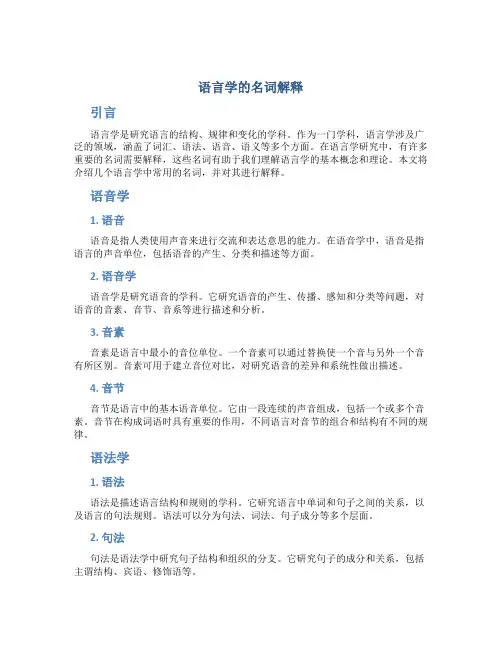
语言学的名词解释引言语言学是研究语言的结构、规律和变化的学科。
作为一门学科,语言学涉及广泛的领域,涵盖了词汇、语法、语音、语义等多个方面。
在语言学研究中,有许多重要的名词需要解释,这些名词有助于我们理解语言学的基本概念和理论。
本文将介绍几个语言学中常用的名词,并对其进行解释。
语音学1. 语音语音是指人类使用声音来进行交流和表达意思的能力。
在语音学中,语音是指语言的声音单位,包括语音的产生、分类和描述等方面。
2. 语音学语音学是研究语音的学科。
它研究语音的产生、传播、感知和分类等问题,对语音的音素、音节、音系等进行描述和分析。
3. 音素音素是语言中最小的音位单位。
一个音素可以通过替换使一个音与另外一个音有所区别。
音素可用于建立音位对比,对研究语音的差异和系统性做出描述。
4. 音节音节是语言中的基本语音单位。
它由一段连续的声音组成,包括一个或多个音素。
音节在构成词语时具有重要的作用,不同语言对音节的组合和结构有不同的规律。
语法学1. 语法语法是描述语言结构和规则的学科。
它研究语言中单词和句子之间的关系,以及语言的句法规则。
语法可以分为句法、词法、句子成分等多个层面。
2. 句法句法是语法学中研究句子结构和组织的分支。
它研究句子的成分和关系,包括主谓结构、宾语、修饰语等。
3. 词法词法是语法学中研究词汇和词法规则的分支。
它研究词汇的构成和分类,包括词根、词缀、词义等方面。
4. 句子成分句子成分是组成句子的不可再分的最小单位。
在句子中,包括主语、谓语、宾语、定语、状语等多个句子成分,它们各自具有不同的语法功能。
语义学1. 语义语义是研究词义和语言意义的学科。
它研究词汇和句子的意义,以及语言表达的信息和引申。
2. 语义学语义学是研究语言意义的学科。
它研究语言中的词义、句义、语境等方面的问题,揭示词语和句子的真正含义。
3. 词义词义是一个词所具有的意义。
在语义学中,词义可以通过定义、例句和语境等方式来解释和理解。
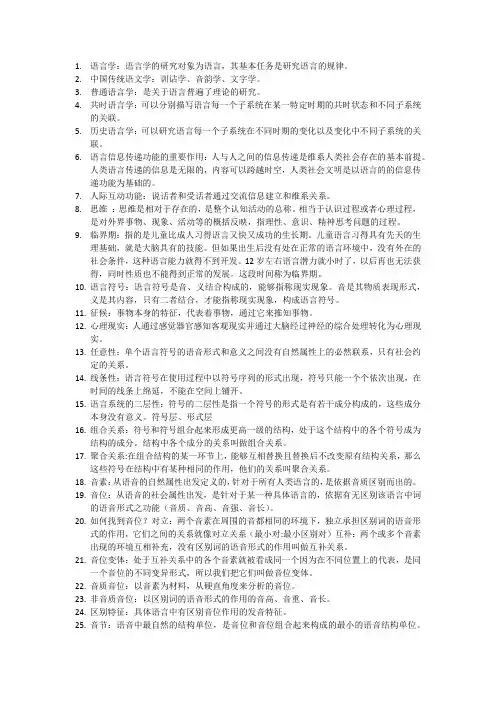
1.语言学:语言学的研究对象为语言,其基本任务是研究语言的规律。
2.中国传统语文学:训诂学、音韵学、文字学。
3.普通语言学:是关于语言普遍了理论的研究。
4.共时语言学:可以分别描写语言每一个子系统在某一特定时期的共时状态和不同子系统的关联。
5.历史语言学:可以研究语言每一个子系统在不同时期的变化以及变化中不同子系统的关联。
6.语言信息传递功能的重要作用:人与人之间的信息传递是维系人类社会存在的基本前提。
人类语言传递的信息是无限的,内容可以跨越时空,人类社会文明是以语言的的信息传递功能为基础的。
7.人际互动功能:说话者和受话者通过交流信息建立和维系关系。
8.思维:思维是相对于存在的,是整个认知活动的总称。
相当于认识过程或者心理过程,是对外界事物、现象、活动等的概括反映,指理性、意识、精神思考问题的过程。
9.临界期:指的是儿童比成人习得语言又快又成功的生长期。
儿童语言习得具有先天的生理基础,就是大脑具有的技能。
但如果出生后没有处在正常的语言环境中,没有外在的社会条件,这种语言能力就得不到开发。
12岁左右语言潜力就小时了,以后再也无法获得,同时性质也不能得到正常的发展。
这段时间称为临界期。
10.语言符号:语言符号是音、义结合构成的,能够指称现实现象。
音是其物质表现形式,义是其内容,只有二者结合,才能指称现实现象,构成语言符号。
11.征候:事物本身的特征,代表着事物,通过它来推知事物。
12.心理现实:人通过感觉器官感知客观现实并通过大脑经过神经的综合处理转化为心理现实。
13.任意性:单个语言符号的语音形式和意义之间没有自然属性上的必然联系,只有社会约定的关系。
14.线条性:语言符号在使用过程中以符号序列的形式出现,符号只能一个个依次出现,在时间的线条上绵延,不能在空间上铺开。
15.语言系统的二层性:符号的二层性是指一个符号的形式是有若干成分构成的,这些成分本身没有意义。
符号层、形式层16.组合关系:符号和符号组合起来形成更高一级的结构,处于这个结构中的各个符号成为结构的成分。

语言学的名词解释序论部分语言学:是以语言作为专门研究对象的一门独立的科学;从方法上分为历史语言学、比较语言学、历史比较语言学、描写语言学;从研究对象上可分为个别语言学和普通语言学;19C初的历史比较语言学标志着语言学的诞生。
历史语言学:用历史的方法来考察语言的历史演变、研究它的变化规律的语言学。
比较语言学:用比较的方法,对不同的语言进行对比研究,找出它们相异之处或共同规律的语言学。
表层结构、深层结构:表层结构和深层结构相对,表层结构赋予句子以一定的语音形式,即通过语音形式所表达出来的那种结构,表层结构是由深层结构转换而显现的;深层结构是赋予句子以一定的语义解释的那种结构。
语言的社会功能语言的依存性(强制性):语言符号的音义结合是任意的,但一经社会约定俗成后,音义之间就具有互相依存的关系,不得任意更改。
语言层级性:语言是一种分层装置。
语言结构要素的各个单位,在语言结构中,并非处在同一个平面上,而是分为不同的层和级。
语言可分为二层——底层是一套音位和由音位组成的音节,为语言符号准备了形式部分;上层是音义结合的符号和符号的序列,分为三级:第一级是词素,是构词材料';第二级是词,是造句材料;第三级是句子,是交际的基本单位。
语言发展的渐变性:指语言从旧质过渡到新质不是经过爆发,不是经过消灭现存的语言和创造新的语言,而是经过新质要素的逐渐积累,旧质要素的逐渐死亡来实现的。
语言结构的体系的演变只能采取渐变,不能爆发突变。
语言发展的不平衡性:指语言结构体系发展变化是不平衡的,即词汇、语义、语音、语法的发展速度是不一样的。
与社会联系最直接的词汇、语义变化最快,语音次之,语法最慢。
组合关系:构成线性序列的语言成分之间前后相继的关系。
语言单位顺着时间的线条前后相继,好像一根链条,一环扣着一环,处于这个组合链中的两个符号或符号序列之间的关系就叫组合关系。
如:主谓、动宾等都是具体的组合关系类型。
聚合关系:在线性序列的某一结构位置上语言成分之间相互替换的关系。
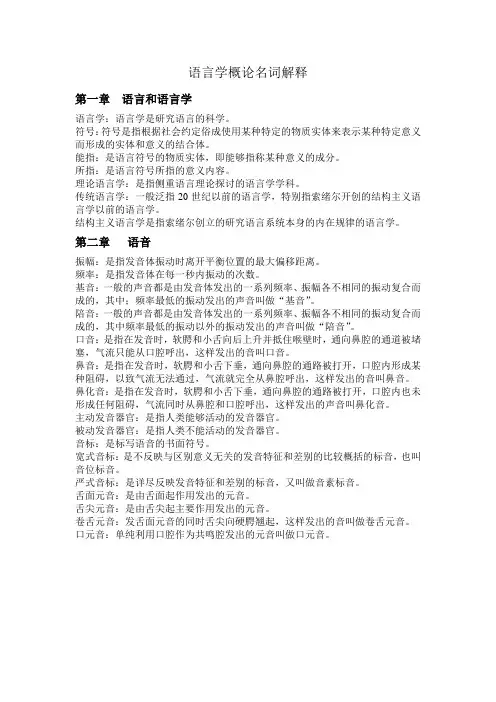
语言学概论名词解释第一章语言和语言学语言学:语言学是研究语言的科学。
符号:符号是指根据社会约定俗成使用某种特定的物质实体来表示某种特定意义而形成的实体和意义的结合体。
能指:是语言符号的物质实体,即能够指称某种意义的成分。
所指:是语言符号所指的意义内容。
理论语言学:是指侧重语言理论探讨的语言学学科。
传统语言学:一般泛指20世纪以前的语言学,特别指索绪尔开创的结构主义语言学以前的语言学。
结构主义语言学是指索绪尔创立的研究语言系统本身的内在规律的语言学。
第二章语音振幅:是指发音体振动时离开平衡位置的最大偏移距离。
频率:是指发音体在每一秒内振动的次数。
基音:一般的声音都是由发音体发出的一系列频率、振幅各不相同的振动复合而成的,其中;频率最低的振动发出的声音叫做“基音”。
陪音:一般的声音都是由发音体发出的一系列频率、振幅各不相同的振动复合而成的,其中频率最低的振动以外的振动发出的声音叫做“陪音”。
口音:是指在发音时,软腭和小舌向后上升并抵住喉壁时,通向鼻腔的通道被堵塞,气流只能从口腔呼出,这样发出的音叫口音。
鼻音:是指在发音时,软腭和小舌下垂,通向鼻腔的通路被打开,口腔内形成某种阻碍,以致气流无法通过,气流就完全从鼻腔呼出,这样发出的音叫鼻音。
鼻化音:是指在发音时,软腭和小舌下垂,通向鼻腔的通路被打开,口腔内也未形成任何阻碍,气流同时从鼻腔和口腔呼出,这样发出的声音叫鼻化音。
主动发音器官:是指人类能够活动的发音器官。
被动发音器官:是指人类不能活动的发音器官。
音标:是标写语音的书面符号。
宽式音标:是不反映与区别意义无关的发音特征和差别的比较概括的标音,也叫音位标音。
严式音标:是详尽反映发音特征和差别的标音,又叫做音素标音。
舌面元音:是由舌面起作用发出的元音。
舌尖元音:是由舌尖起主要作用发出的元音。
卷舌元音:发舌面元音的同时舌尖向硬腭翘起,这样发出的音叫做卷舌元音。
口元音:单纯利用口腔作为共鸣腔发出的元音叫做口元音。
![《语言学纲要》复习资料(名词解释)[1]](https://uimg.taocdn.com/d97cc4e5f80f76c66137ee06eff9aef8941e48ee.webp)
《语⾔学纲要》复习资料(名词解释)[1]《语⾔学纲要》复习资料(名词解释)1、语⾔:语⾔是⼀个⾳义结合的符号系统,是⼈类独有的、最重要的交际⼯具,同时也是思维⼯具。
2、语⾔学:语⾔学是以⼈类语⾔作为研究对象的学科,研究⼈类语⾔的性质、结构、发展及其在社会⽣活中的运⽤以及语⾔研究成果的应⽤问题,等等。
分理论语⾔学和应⽤语⾔学两个领域。
3、语⽂学:⼈类最早的语⾔研究是从解释古代⽂献开始的,是为了研究哲学、历史和⽂学⽽研究语⾔的。
我们把这种依附于其他学科存在的语⾔研究成为语⽂学。
4、“⼩学”:在中国古代,⼩学先从教授字的形(六书)、⾳、义开始,就把研究⽂字、训诂、⾳韵⽅⾯的学问统称为⼩学。
⼩学⼀直是经学的⼀部分,包括⾳韵学、训诂学、⽂字学三个分⽀学科,5、理论语⾔学:普通语⾔学的⼀个部分,与应⽤语⾔学相对。
主要以语⾔系统的描写、语⾔运⽤机制、语⾔能⼒以及语⾔发展的历史为主要的研究对象。
6、语⾔的两个有限任何⼀种语⾔都是⼀个⾳义结合的符号系统,其中作为基本符号的语素和词在数量上是有限的,把语素或词组合起来构成词组或句⼦的规则也是有限的。
语⾔的这两个有限性是区别⾔语活动的基本特征。
7、⾔语活动的两个⽆限⾔语活动是以语⾔为⼯具展开的交际或思维活动,其中作为这个活动的最基本的单位——句⼦,在理论上可以是⽆限长的,在数量上可以是是⽆限多的。
8、⼤脑左右半球分⼯⼈类⼤脑左右半球分⼯不同,左脑主管语⾔、逻辑、书写及右侧肢体运动,⽽右脑主管⾊彩、空间感、节奏和左侧肢体运动。
⼤脑两半球分⼯是⼈类特有的,但出⽣婴⼉⼤脑两半球没有分⼯。
9、⾮语⾔交际⼯具或副语⾔交际⼯具⼈们在运⽤语⾔进⾏交际的时候,不但动嘴,⽽且脸部的表情、⼿的动作、乃⾄整个躯体的姿态等⾮语⾔的东西也都参加进来。
我们这些⾮语⾔的交际⼯具称为副语⾔交际⼯具。
副语⾔交际⼯具的使⽤范围⾮常有限,只能起辅助性的交际作⽤,以补充语⾔交际的某些不⾜。
10、辅助性交际⼯具指的⽂字、旗语、电报代码等在语⾔的基础上产⽣的交际⼯具。
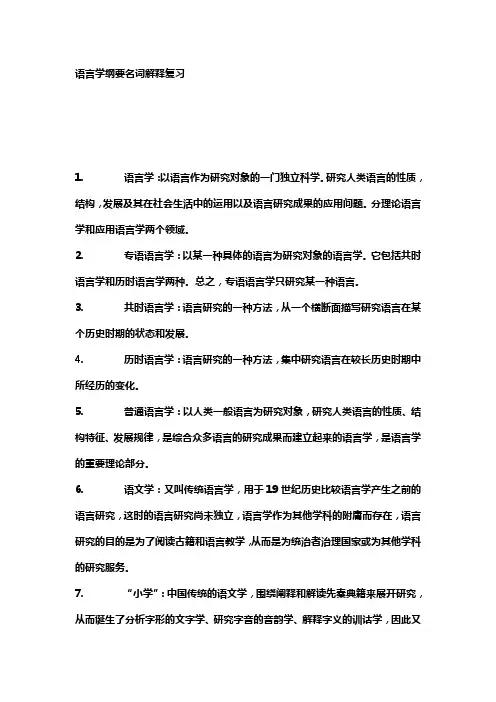
语言学纲要名词解释复习1. 语言学:以语言作为研究对象的一门独立科学。
研究人类语言的性质,结构,发展及其在社会生活中的运用以及语言研究成果的应用问题。
分理论语言学和应用语言学两个领域。
2. 专语语言学:以某一种具体的语言为研究对象的语言学。
它包括共时语言学和历时语言学两种。
总之,专语语言学只研究某一种语言。
3. 共时语言学:语言研究的一种方法,从一个横断面描写研究语言在某个历史时期的状态和发展。
4. 历时语言学:语言研究的一种方法,集中研究语言在较长历史时期中所经历的变化。
5. 普通语言学:以人类一般语言为研究对象,研究人类语言的性质、结构特征、发展规律,是综合众多语言的研究成果而建立起来的语言学,是语言学的重要理论部分。
6. 语文学:又叫传统语言学,用于19世纪历史比较语言学产生之前的语言研究,这时的语言研究尚未独立,语言学作为其他学科的附庸而存在,语言研究的目的是为了阅读古籍和语言教学,从而是为统治者治理国家或为其他学科的研究服务。
7. “小学”:中国传统的语文学,围绕阐释和解读先秦典籍来展开研究,从而诞生了分析字形的文字学、研究字音的音韵学、解释字义的训诂学,因此又被人们称为经学的附庸。
8. 应用语言学:狭义的应用语言学指语言教学,文字的创制和改革,正音正字,词典编纂等,广义的应用语言学还包括与计算机有关的机器翻译,情报检索,语音识别,自然语言处理等。
9. 历史比较语言学:19世纪30年代兴起的一个语言学的重要的流派,它以历史比较法为基础,研究语言的亲属关系以及发展历史。
它的出现为现代语言学的建立奠定了坚实的基础,是语言学走上独立发展道路的标志。
1. 语言:是一种特殊的社会现象,是人类作为必不可少的思维工具和最重要的交际工具来使用的一种音义结合的符号系统。
2. 说话:运用语言跟人们交流思想的行为,本身不等于语言。
3. 言语:是对语言的运用,它有两个意思:一是指人的说和写的过程,是人的一种行为,叫言语活动,也叫言语行为;一是指人说出来的话,写出来的东西,也叫言语作品。
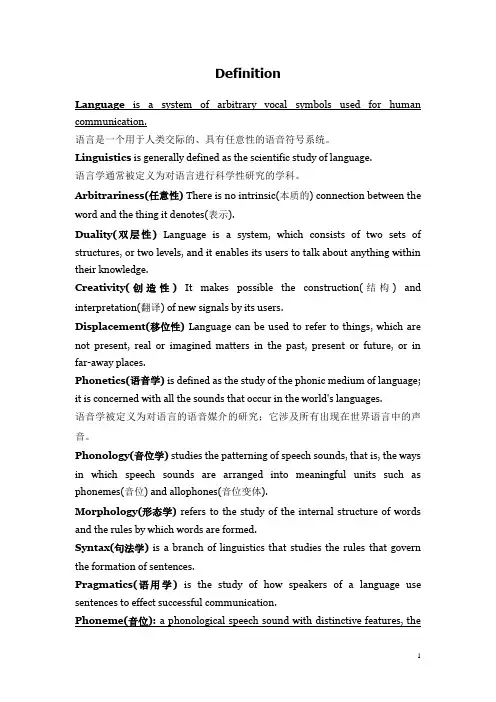
DefinitionLanguage is a system of arbitrary vocal symbols used for human communication.语言是一个用于人类交际的、具有任意性的语音符号系统。
Linguistics is generally defined as the scientific study of language.语言学通常被定义为对语言进行科学性研究的学科。
Arbitrariness(任意性) There is no intrinsic(本质的) connection between the word and the thing it denotes(表示).Duality(双层性) Language is a system, which consists of two sets of structures, or two levels, and it enables its users to talk about anything within their knowledge.Creativity(创造性) It makes possible the construction(结构) and interpretation(翻译) of new signals by its users.Displacement(移位性) Language can be used to refer to things, which are not present, real or imagined matters in the past, present or future, or in far-away places.Phonetics(语音学) is defined as the study of the phonic medium of language; it is concerned with all the sounds that occur in the world's languages.语音学被定义为对语言的语音媒介的研究;它涉及所有出现在世界语言中的声音。
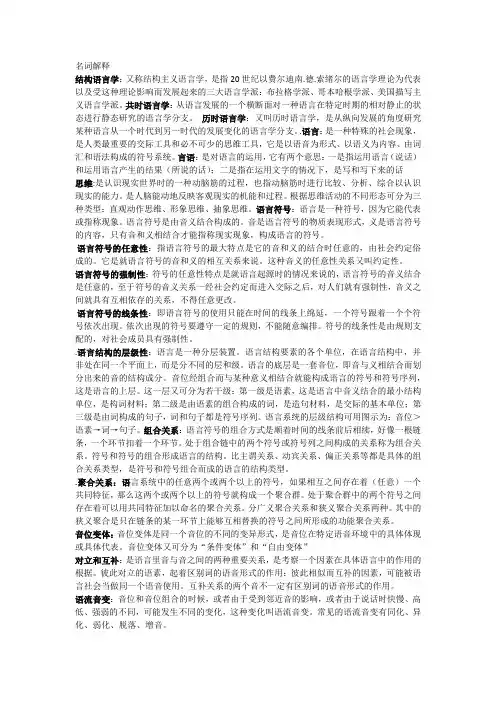
名词解释结构语言学:又称结构主义语言学,是指20世纪以费尔迪南.德.索绪尔的语言学理论为代表以及受这种理论影响而发展起来的三大语言学派:布拉格学派、哥本哈根学派、美国描写主义语言学派。
共时语言学:从语言发展的一个横断面对一种语言在特定时期的相对静止的状态进行静态研究的语言学分支。
历时语言学:又叫历时语言学,是从纵向发展的角度研究某种语言从一个时代到另一时代的发展变化的语言学分支。
.语言:是一种特殊的社会现象,是人类最重要的交际工具和必不可少的思维工具,它是以语音为形式、以语义为内容、由词汇和语法构成的符号系统。
言语:是对语言的运用,它有两个意思:一是指运用语言(说话)和运用语言产生的结果(所说的话);二是指在运用文字的情况下,是写和写下来的话思维:是认识现实世界时的一种动脑筋的过程,也指动脑筋时进行比较、分析、综合以认识现实的能力。
是人脑能动地反映客观现实的机能和过程。
根据思维活动的不同形态可分为三种类型:直观动作思维、形象思维、抽象思维。
语言符号:语言是一种符号,因为它能代表或指称现象。
语言符号是由音义结合构成的。
音是语言符号的物质表现形式,义是语言符号的内容,只有音和义相结合才能指称现实现象,构成语言的符号。
语言符号的任意性:指语言符号的最大特点是它的音和义的结合时任意的,由社会约定俗成的。
它是就语言符号的音和义的相互关系来说。
这种音义的任意性关系又叫约定性。
语言符号的强制性:符号的任意性特点是就语言起源时的情况来说的,语言符号的音义结合是任意的,至于符号的音义关系一经社会约定而进入交际之后,对人们就有强制性,音义之间就具有互相依存的关系,不得任意更改。
语言符号的线条性:即语言符号的使用只能在时间的线条上绵延,一个符号跟着一个个符号依次出现。
依次出现的符号要遵守一定的规则,不能随意编排。
符号的线条性是由规则支配的,对社会成员具有强制性。
.语言结构的层级性:语言是一种分层装置。
语言结构要素的各个单位,在语言结构中,并非处在同一个平面上,而是分不同的层和级。
1)Linguistics is generally defined as the scientific or systematic study of (human) language.a.The word language preceded by zero article in English implies that linguistics studies not any particular language, e.g. English , Chinese , French and Japanese, but languages in general.b.The word study does not mean “learn” but “investigate”.c.The word scientific refers to the way in whichlanguage is studied.It is a science in the sense that it scientifically studies the rules,systems and principles of human languages. It deals with a wide range of linguistic phenomena,analyzes them,and makes general statements about them.2)Linguistics is always guided by the 3 canons of science:(e c e)exhaustiveness: it strives for thorough-goingness in the examination of relevant materials;consistency: there should be no contradiction between different parts of the total statementeconomy: other things being equal, a shorter statement or analysis is to be preferred to one that is longer or more complex. (e c e)3) The subject matter of linguistics is all natural language, living or dead.4) Linguistics has 2 main purposes:it studies the nature of language and tries to establish a theory of language, and describes languages in the light of the theory established.It examines all the forms of language in general and seeks a scientific understanding of the ways in which it is organized to fulfill the needs it serves and the functions it performs in human lifelinguistics differs from traditional grammar at least in 3 basic ways: Linguistics describes languages and does not lay down rules of correctness. Linguists are interested in what is said. So they are often said to be descriptive. Linguists regard the spoken language as primary. It is believed that speech came into being first for any human language and the writing system came along much later. Traditional grammar is based on Latin and it tries to impose the Latin categories and structures on other languages, while linguistics describes each language on its own merits.For a student of language, some knowledge of linguistics is of both interest and importance.For a teacher of foreign languages, he will definitely a great deal from the knowledge of linguistics.For a researcher, there is even more scope for displaying his abilities.Why study linguistics ?1. Linguistics takes an analytical approach to the study of language, andfocus on developing skills in data analysis, problem solving, and logical thinking that can be applied to many fields.2.It is an interdisciplinary subject.3.Linguistics is a science that is still in its infancy but undergoing rapiddevelopment, and it is “a pilot science”.What and how linguists study language?1. nature of language (focus on language itself)2. nature of acquisition (focus on learners)3. nature of teaching (focus on teachers)The process of linguistic study can be summarized as follows:.First, certain linguistic facts are observed, and generalizations are made about them;.Next, based on these generalizations, hypotheses are tested by further observations;.And finally a linguistic theory is constructed about what language is and how it works.General linguistics: The study of language as a whole. It deals with the basic concepts, theories, descriptions, models and methods applicable in any linguistic study.Microlinguistics(微观语言学)includes 6 branches, namely, phonetics, phonology, morphology, syntax, semantics and pragmatics. It studies language itself. Macrolinguistics (宏观语言学)studies language in use--- practical usage. macrolinguistics includes:Sociolinguistics studies the relations between language and society: how social factors influence the structure and use of language. Another name for sociolinguistics is the sociology of language.Psycholinguistics is the study of language and mind: the mental structures and processes which are involved in the acquisition, comprehension and production of language.Neurolinguistics or neurological linguistics is the study of language processing and language representation in the brain.Stylistics is the study of how literary effects can be related to linguistic features. It usually refers to the study of written language, including literary texts, but it also investigates spoken language sometimes.Discourse analysis, or text linguistics is the study of the relationship between language and the contexts in which language is used.Computational linguistics is an approach to linguistics which employs mathematical techniques, often with the help of a computer.Cognitive linguistics is an approach to the analysis of natural language that focuses on language as an instrument for organizing, processing, and conveying information.Apart from the different branches of linguistics, there are some distinctions of linguistics, such as: functional linguistics vs formal linguistics; theoretical linguistics vs applied linguistics.Applied linguistics is primarily concerned with the application of linguistic theories, methods and findings to the elucidation of language problems which havearisen in other areas of experience.Phonetics(语音学):Phonetics is the scientific study of speech sounds.It studies how speech sounds are articulated, transmitted, and received. It is a pure science and examines speech sounds in general.Phonetics: The general study of the characteristics of speech sounds.Phonology(音系学/音位学): The description of the systems and patterns of speech sounds in a language.Phonology is the study of how speech sounds function in a language. It studies the ways speech sounds are organized. It can be seen as the functional phonetics of a particular language.Morphology(形态学,词法学):The study of the way in which morphemes are arranged to form words.Morphology is the study of the formation of words. It is a branch of linguistics which breaks words into morphemes.Syntax(句法学):The study of those rules that govern the combination of words to form permissible sentences.Syntax deals with the combination of words into phrases, clauses and sentences. It is the grammar of sentence construction.Semantics(语义学) is a branch of linguistics which is concerned with the study of meaning in abstraction.Pragmatics can be defined as the study of language in use. It deals with how speakers use language in ways which cannot be predicted from linguistic knowledge alone, and how hearers arrive at the intended meaning of speakers. In a broad sense, pragmatics studies the principles observed by human beings when they communicate with one another.Language is a system of arbitrary vocal symbols used for human communication.This definition is widely accepted because it includes some of the important characteristics of human language.Language as system ---The key word in the definition is "system". Language is systematic. Otherwise we would not be able to learn or use it consistently. Each language system contains two subsystems: a system of sound and a system of meaning. Language is a system—elements in it are not arranged and combined randomly, but according to some rules and principles.Language as arbitrary ---There is no natural relationship between the sound and what it means in a certain language.The relation between sound and meaning is almost always arbitrary or conventional. The relation between sound and meaning is almost always arbitrary.A rose by any other name would smell as sweet.A rose by any other name would smell as sweet.Romeo and JulietThe relation between sound and meaning is almost always conventional《荀子·正名》:“名无固宜,约之以命,约定俗成谓之宜,异于约则谓之不宜。
语言学的名词解释语言学是一门研究语言的科学,它涉及到语言的结构、演化、习得和使用等方面。
作为一门跨学科的学科,语言学结合了语言、语法、心理学和社会学等多个学科的研究成果。
本文将从不同角度解释语言学中的几个核心概念。
一、语言语言是人类特有的交流工具,通过声音、文字和手势等方式进行信息传递。
语言可以被认为是一种符号系统,它由音素、音节、词汇和句法等组成。
通过语言,人们能够表达自己的思想、感情和需求。
语言是人类认知能力的产物,它反映了人类对世界的理解和思考方式。
二、语言的结构语言的结构包括语音、语法和语义三个方面。
语音是研究语言的最基本单位,它关注的是语音的产生、传播和接收等过程。
语法是研究语言句子的构成和组织规则的学科,它包括词法、句法和语用等方面。
语义是研究语言意义的学科,它关注的是词汇和句子的意义以及其与世界之间的关系。
三、语言的演化语言是随着人类社会发展而演化的,它经历了数千年的变迁。
语言的演化可以分为内部演化和外部演化两个方面。
内部演化指的是语言自身在使用过程中发生的变化,包括音变、词汇演变和语法演变等。
外部演化则是指语言之间相互影响、交流和借鉴的过程,包括语言接触、语言借词和语言迁移等。
四、语言的习得语言的习得是指儿童在成长过程中学会和掌握母语的过程。
语言的习得是符合人类生理和心理规律的,儿童在特定的环境中通过听、说、读、写等方式逐渐掌握母语。
语言习得涉及到词汇的习得、语音的习得和句法的习得等方面。
语言习得的过程中也受到社会环境和文化背景的影响。
五、语言的使用语言是为了沟通交流而存在的工具,人们可以通过语言表达信息、传递意义和共享知识。
语言的使用包括交际、交流和表达等方面。
通过语言的使用,人们能够与他人建立联系、构建社会关系和形成共同的认知。
语言的使用还受到社会语言规范、文化价值观和情境因素的影响。
总结:语言学作为一门研究语言的学科,涵盖了广泛而丰富的内容。
从语言的结构到演化,从习得到使用,语言学研究了人类语言的方方面面。
语言学的的名词解释是什么语言学的名词解释是什么语言学是一门研究人类语言的学科,它探讨着语言的结构、变异、演化以及语言与思维的关系。
作为一门跨学科的学科,语言学涵盖了诸多子领域,如音韵学、语法学、语义学、语用学等。
本文将为读者解释一些与语言学相关的名词,以期加深对这门学科的理解。
1. 语言语言是人类思维交流的基本工具,通过声音、文字和手势等方式表达。
语言可以是口头的,如汉语、英语;也可以是书面的,如拉丁文、阿拉伯文。
语言是一种符号体系,具有一定的语法规则来构建和解析有意义的表达。
不同语言之间存在着语法、词汇和语音的差异。
2. 音韵学音韵学是语言学的一个分支,研究语言中的音素(最小语音单位)和音位(实际发声的音素)的组合和变化规律。
音韵学家关注语音的特性、音位的分布和发音的变体。
通过研究不同语言中的语音系统,音韵学帮助我们更好地了解语言的声音组织。
3. 语法学语法学研究语言中的结构和规则,探究如何构建有意义的句子。
它包括词法(单词和词汇的形态学和构成规则)和句法(句子的结构和组织规则)两个方面。
语法学家研究语言的句子结构、句子成分的分类和关系,以及不同语言中的语序、时态等变化。
4. 语义学语义学关注语言中词汇和句子的意义,研究语言符号和其所表示的概念之间的关系。
语义学家探讨语言中的词义、句义和逻辑推理。
通过研究语义学,我们可以理解为什么同一个概念在不同语言中可能有不同的表达方式。
5. 语用学语用学研究语言在特定上下文中的使用和理解,关注言语行为的目的、意图和效果。
语用学家研究言语行为规范、会话合作原则、语用推理等。
语用学帮助我们理解为何同样的句子在不同场景中可能有不同的含义。
6. 语言演化语言演化研究语言的变化和发展,探寻语言是如何从一个共同的祖先语言发展出多样的语言家族。
语言演化研究领域包括比较语言学、历史语言学和古代语言学等。
通过研究语言的演化,我们可以了解语言是如何随时间变化的,为什么不同语言之间存在相似性和差异性。
语言学名词解释汇总语言学名词解释汇总(仅供参考,不足处请大家补充)一、名词解释。
1、语言学:①~是以语言作为专门研究对象的一门独立的科学;②从方法上分为历史…、比较…、历史比较…、描写…;从研究对象上可分为个别…和普通…;③19世纪初的历史比较学标志着语言学的诞生。
2、语文学:…是为给古代文化遗产——政治历史文学等方面的经典书面著作作注释,目的是使人们可以读懂古书的一门尚未独立的学科。
3、小学:指我国古代传统的文学学、音韵学和训诂学,虽然我国古代没有语文学,但一般认为…属于语文学的范围。
4、训诂:是解释字义和研究它的演变的一门学科,其目的是从词义方面来解释古书的文字。
5、专语语言学:以某种具体的语言为研究对象的语言学称为…。
*共时语言学和历时语言学:根据语言体系的稳固和变化,把语言研究分为共时的和历时的研究,共时…研究的是在特定时期内相对稳固的语言体系,如对现代汉语的研究;历时…研究的则是描写语言体系的历史演变,如对汉语发展史的研究。
*普通语言学:是对人类语言从理论方面进行研究的一门学科,它探索各种语言所共有的规律以及各种语言在结构上的共同特点。
*历史语言学:用历史的方法来考察语言的历史演变、研究它的变化规律的语言学称为…。
*比较语言学:用比较的方法,对不同的语言进行对比研究,找出它们相异之处或共同规律的叫…。
6、表层结构和深层结构:表层结构和深层结构相对,表层结构赋予句子以一定的语音形式,即通过语音形式所表达出来的那种结构,表层结构是由深层结构转换而显现的;深层结构是赋予句子以一定的语义解释的那种结构。
7、语言:是从言语中概括出来的音义结合的词汇系统和语法系统。
*言语:是说的行为和结果。
*说话:是人们运用语言工具表达思想所产生的结果。
8、语言层级性(二层性):语言是一种分层装置。
语言结构要素的各个单位,在语言结构中,并非处在同一个平面上,而是分为不同的层和级。
语言可分为二层——底层是一套音位和由音位组成的音节;上层分为三级:第一级是词素,是构词材料';第二级是词,是造句材料;第三级是句子,是交际的基本单位。
When I was preparing the postgraduate entrance examination of NNU(Nanjing Normal University),some of these following concepts had been tested,but there's no specific or clear explanation in the textbook required by the university.As in preparing the second-round examination I read them in other relevant books, I wrote down here for your reference.Hope they are useful to some of you.1. Acculturation(同化过程)is a process in which members of one cultural group adopt the beliefs and behaviors of another group.2. Adjacency pair(相邻语对);a sequence of two utterances by different speakers in conversation. The second is a response to the first, such as question/answer sequences and greeting/greeting exchange.3. affix: a bound morpheme that is attached to a stem and modifies its meaning in some way.4. agreement (concord)(一致): a grammatical phenomenon in which the form of one word in a sentence is determined by the form of another word which is grammatically linked to it. E.g. in the sentence The boy goes to school every day.There is an agreement in number between boy and goes.5.articulators(发音器官): the tongue,lips,and velum, which change the shape of the vocal tract to produce different speech sounds.6.aspect(体): the grammatical category representing distinction in the temporal structure of an event. English has two aspect construction---the perfect and the progressive.(完成体和进行体)7.aspiration(吐气); the puff of air that sometimes follows the pronounciation of a stop consonant.E.g. /p/ in the word pit.8.consonant(辅音); a speech sound produced by partial or complete closure of part of the vocal tract, thus obstructing the airflow and creating audible friction. Consonants are described in terms of voicing, place of articulation, and manner of articulation.9. converstional implicature(会话含义):meanings that are explicable in the light of converational maxims.municative competence(交际能力); the ability to use language appropriately in social situations.11. constituent(成分): a syntactic unit that functions as part of a large unit within a sentence; typical constituent types are verb phrase, noun phrase, prepositional phrase and clause.12.case(格):the grammatical category in inflectional languages by which the form of a noun or noun phrase varies for grammatical or semantic reasons. English has only one case distinction in nouns—the genitive case(所有格), but English pronouns have three forms that correspond to three of the six cases in Latin.13.clause(小句): a grammatical unit that contains a subject and a predicate. It may be a sentence or part of a sentence.14.closed class(封闭词类): a group of words whose membership is small and does not readily accept new members.15.coinage(创新词): the construction and addition of new words.16.distribution(分布): the set of positions in which a given linguistic element or form can appear in a language.17.duality(双重结构): a type of double-layer structure in which a small number of meaningless units are combined to produce a large number of meaningful units.18.entailment(包含); the relationship between two sentences where the truth of one(the second)is inferred from the truth of the other.19.euphemism(委婉语): a word or phrase that replaces a taboo word or is used to avoid reference to certain acts or subjects,e.g. powder room for toilet.20.garden path sentence(花园小径句): a sentence in which the comprehender assumes a particular meaning of a word or a phrase but later discovers that the assumption was incorrect, forcing the comprehender to backtrack and reinterpret the sentence21.free variation;(自由变异) a relation between two speech sounds such that either one can occur in a certain position and the substitution of one for the other never makes any difference in the meaning of the word. For instance, the unexploded(失去爆破) stop /d/ in the phrase Good morning is in free varitation with the exploded(爆破)counterpart.22.inflection(屈折变化): the morphological process by which affixes combine with words or stems to indicate such grammatical categories as tense or plurity.ernment(支配): the grammatical phonomenon in which the presence of a particular word in a sentence requires a second word which is grammatical linked with it to appear in a particular form. E.g. a preposition or a verb requires that the pronoun following it be in the objective form,as in with me,to him.nguage universal(语言共性): any property that is shared by most,if not all, human lanugages.25.lingua franca: ( 通用语) A language variety used for communication among groups of people wo do not otherwise share a common language. For example, English is the lingua franca of the international scientific community.26.macrosociolinguistics; The study of the effect of language on society.27.microsociolinguistics: The study of the effect of any and all aspects of society,including cultural norms, expetations and contexts,on the way language is used. It is often simply called sociolinguistics.28.paradigmatic relation: (纵组合关系)The substitutional relation between a set of linguistic items,that is,linguistic forms(letters,words and phrases)can be substituted for each other in the same position in a word or sentence. E.g, b,p,s,f are in paradigmatic relation in the words bit,pit,sit,fit, so are Nature,Beauty, Love, Honesty in the sentences:Nature purifies the mind.Beauty purifies the mind.Love purifies the mind.Honesty purifies the mind.29.syntagmatic relation: (横组合关系) The relation between any linguistic elements which are simultaneously present in a structure. E.g. in the word bit, b, i,t are in syntagmatic relation, so are nature, purifies, the, mind, in the sentence Nature purifies the mind.30.presupposition(预设): implicit assumptions about the world acquired to make an utterance meaningful or appropriate,e,g, “ some tea has already been taken”is a presuppostion of “Take some more tea”.31.prototype(典型): What members of a particular community think of as the best example of a lexical category,e.g.for some English spe akers “cabbage”(rather than,say,carrot)might be the prototypical vegetable.32.root(词根): the morpheme that remains when all affixes are stripped from a complex word. E.g. system from un- + system + atic + ally.33.stem(词干): the base to which one or more affixes are attached to create a more complex form that may be another stem or a word.34.taboo(禁忌语):words that are offensive or embarrassing, considered inappropriate for “polite society”, thus to be avoided in conversation.35.selectional restriction(选择限制): a restriction on the combining of words in a sentence resulting from their meaning.36.linguistic universal:(语言共性) The linguistic universals are principles that enable children to acquire a particular language unconsciously, without instruction in the early years of life. As a whole they are referred to as Universal Grammar.37.contrastive distribution(对比分布):If the speech sounds occur in the same phonetic context and the substitution results a contrast in meaning, we say they are in contrastive distribution.38.immidiate constituent analysis(直接成分分析法)is the technique of breaking up sentences into word groups by making successive binary cuttings until the level of single words is reached.39.endocentric construction: (向心结构或内心结构)One construction whose distribution is functionally equivalent, or approaching equivalence, to one of its constituents. The typical English endocentric constructions are noun phrases and adjective phrases.40.exocentric construction(离心结构或外心结构)the opposite of endocentric construction,refers to a group of syntactically related words where none of the words is functionally equivalent to the whole group. Most constructions are exocentric.41.politeness can be defined as the means employed to show awareness of another person’s public self-image.42.PP(politeness principle)tact maxim;generosity principle;approbation maxim;modesty maxim;agreement maxim;sympathy maxim.43.irony(反语)is the use of words to express something other than and especially the opposite of the literal meaning of the utterance.44.code-switching: (语码转换) means the alternation between two or more languages,language varieties or registers in communication.45.affective filter(情感过滤):A screen of emotion that can block language acquisition or learning if it keeps the learners being too self-conscious or too embarrassed to take risks during communicative exchanges.46.Conversion(转类构词)is a change in the grammatical function of a word without adding or removing any part of it. A word belonging to one part of speech is extended to another part of speech. It is also called functional shift or zero derivation.47.lexical meaning VS grammatical meaning(词汇意义与语法意义)The meaning of a sentence is carried by the words proper as well as by the patterns of word order that is part of the grammatical system of a language. The part of the sentence meaning contributed by words is called the lexical meaning and the part of sentence meaning that depends upon the way the words are put together is called grammatical meaning, in which the function words and the word order play a very important role.48.paralinguistic meaning VS non-linguistic meaning (副语言意义与非语言意义)In human communication, apart from the linguistic meaning conveyed by language itself,there are numerous paralinguistic meanings and non-linguistic meanings that are perceived simultaneously by the hearer. Paralinguistic meanings are those attached to the verbal expressions by quality of voice,tempo of speech,posture,facial expression and gestures. Non-linguistic meanings are thoseindicated by non-verbal noises such as cough, sigh, tongue-clicking, various kinds of body languages and different contexts of situation.49.denotation VS connotation (外延与内涵)Denotation is a straightforward, literal meaning of the word every member of the language speaking community will agree on. Connotation is not the basic meaing of the word but some emotive or evaluative meaings associated with the word by individual language users in their mind.50.linguistic relativity VS linguistic determinism (语言相对论与语言决定论)The Sapir-Wholf Hypothesis states that there is a systematic relationship between the grammatical categories of the language a person speaks and how that person both understands the world and behaves in it. It boils down to two principles: linguistic relativity and linguistic determinism.Linguistic relativity states that disctinctions encoded in one language are unique to that langage alone, and that there is no limit to the structural diversity of languages.Linguistic determinism refers to the idea that the language we use determines, to some extent, the way in which we view and think about the world around us. This concept has two versions; strongdeterminism and weak determinism. The strong version, which has few followers today, holds that language actually determines thought, whereas that weak version, which is widely accepted today, merely holds that language affects thought.。